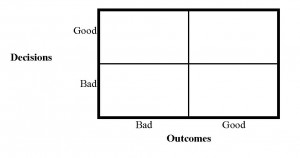Decisions and Outcomes
- October 18, 2021
- Posted by: Philip Struble
- Category: Uncategorized

“Whenever you see a successful business, someone once made a courageous decision.”
Business Decisions
Business decisions fall into three categories: strategic decisions, operational decisions, and managerial decisions.
- Strategic decisions: High-level, non-repetitive decisions not related to the general functioning of an organization.
- Operational decisions: Decisions generally about operations location, production volume, distribution channel, day-to-ay functioning, and office policies made by top management.
- Managerial decisions: Decisions pertaining to resource allocation, talent management, research and development, and new product introduction.
Making Decisions
In all cases, the decision-making process is similar. That process is:
- Defining the problem
- Identifying decision maker
- Gathering information
- Evaluating alternatives and deciding
- Implementation and follow-up
This process has remained unchanged for years, and the difference between a good decision and a poor decision is nearly always found in Step 1 – defining the problem. Good business leaders know that spending more time on this step improves the odds of good outcomes.
Confusion in Decision Making
Experience is the teacher in all decision-making processes. The more decisions made, the more knowledgeable the decision-maker has about defining the problem in such a way that leads to positive results.
But no decision-making process is guaranteed.
Experienced leaders see decision-making as a four-quadrant box. The horizontal axis is the outcomes – good and bad, and the vertical axis are decisions, good and bad. The upper left box is for good decisions/bad outcomes. The lower left is bad decisions/ bad outcomes. The upper right is good decisions and good outcomes. And the lower right is for bad decisions/good outcomes.
The goal of all decisions is good outcomes.
And successful business leaders and entrepreneurs use this four-box graph to help them learn from both successes and failures and to make better choices in the future that lead to better outcomes.

From this four-box matrix, we see that good outcomes come from good decisions. And, bad outcomes come from bad decisions.
But—surprise—it is possible to get good outcomes from bad decisions.
Differences in Decisions.
Every decision has a level of risk.
Hiring a particular employee, investing in a new piece of equipment, and entering a new business market all have a calculable risk. It’s the business leader’s job to consider these risks when making a decision.
Sometimes decisions are made where the risks are high, and sometimes the decisions are only made when the risks are low. Sometimes the outcomes are good, and sometimes the outcomes are low.
There are two problems with the decision-making process.
First, business leaders take credit for all good outcomes, regardless if the decisions are good or bad. The pitfall of this fallacy is business leaders too often become over-confident in their decision-making skills.
And secondly, without understanding and see the four-box matrix, the business leaders gain no educational value for future decision making.
Make Better Decisions
Business leaders and entrepreneurs need to:
- Develop a system to assign a percent chance of success on all decisions.
- Set a limit where a higher percentage chance of success is a bad decision and a lower percentage a good decision.
- Chart all their decisions based on good versus bad decisions and outcomes.
- Be open to see how your decision-making skills result in good outcomes.
The Bible
The problem in evaluating decisions is that a business manager, in an effort to make only good decisions, only takes on the low-risk choices. Luke 14:28-30 says.
“Suppose one of you wants to build a tower. Won’t you first sit down and estimate the cost to see if you have enough money to complete it? For if you lay the foundation and are not able to finish it, everyone who sees it will ridicule you, saying, ‘This person began to build and wasn’t able to finish.’
First, this verse is about building a tower. In biblical times, constructing a tower was a big undertaking. The advice here is not about small, secure, and safe undertakings. Building a tower is a metaphor for making big, audacious plans.
And second, counting the cost is doing the work to evaluate the risk. It is not relying on chance, or someone else to build the tower, or finding ways to avoid making the decision.
Building a company is about taking risks. There is no place for a business leader who wants to settle for only low-risk decisions.
If you want to make good decisions with good outcomes, be prepared to make bad decisions with good outcomes, and good decisions with bad outcomes. Only then will you have the experience to make better decisions more frequently.
